Like most of my experiments, my fabric dyeing results are always interesting and unexpected.
Since I’m not trying to produce anything in particular, I just use good old Rit. It’s inexpensive and the Rit website has a fun
color guide where you can click on any color and get the dye recipe.
My first experiment was with ombre dyeing. Let me suggest that if you want to do ombre dyeing, use a
lightweight fabric or garment. I had an old bathrobe which was made of cotton brocade, lined with French terry! When this thing gets wet, it weighs at least 15 pounds.
The robe was white, and although it was elegant many years ago, white is not a good color for my lifestyle, especially in the mornings when I’m drinking coffee, feeding dogs, watering plants, and the like. So a bright color was called for.
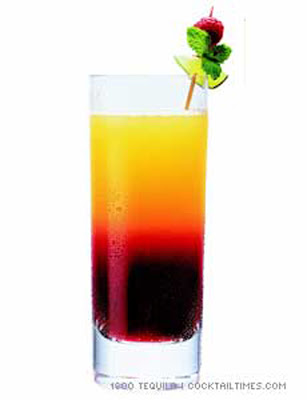
A Tequila Sunrise was my inspiration, partly because I wear the robe at sunrise, and also because I love the color combination: violet red to orange to peachy-yellow.
The first step was easy – I just dyed the entire robe in the washing machine using yellow with a drop of red for the lightest color. The remaining color layers had to be done in the sink, and that’s when things got difficult. I had nothing from which to suspend the robe, so I had to hold it up with one hand while stirring the dye with the other. I submerged the lower half of the robe and sleeves into a red-orange mixture for 20 minutes, and then rinsed it in cold water. Finally I dunked the bottom 8 to 10 inches into a violet dye and let it absorb upwards. At this point I realized what should have been obvious: purple and yellow make BROWN, not purple. So I had a muddy rust color at the hem where I’d hoped for a deep maroon violet.
 After washing and drying, I was pleased overall with the results, even if I did have brown instead of violet. It was a bit bright though, and sometimes I don’t want to see that much vivid color first thing in the morning!
After washing and drying, I was pleased overall with the results, even if I did have brown instead of violet. It was a bit bright though, and sometimes I don’t want to see that much vivid color first thing in the morning!
Well I didn’t have to worry about that, because the next time I washed it, I must have used hot water, because half of the dye ran out.
 It is now a light salmon color fading into apricot at the top. I love it, even though it was completely different from what I’d planned.
It is now a light salmon color fading into apricot at the top. I love it, even though it was completely different from what I’d planned.
My next project, a few months later, was to give some old shirts a new life. A couple of white cotton tees and an old Indian cotton tunic went into the machine with kelly green dye and a few drops of yellow.
 The result was this medium green – it’s brighter than olive, darker than chartreuse, and I don’t know what to call it. But I like it. It’s especially nice that the rayon threads in the embroidery on the tunic picked up the dye so well. Yippee! New shirts!
The result was this medium green – it’s brighter than olive, darker than chartreuse, and I don’t know what to call it. But I like it. It’s especially nice that the rayon threads in the embroidery on the tunic picked up the dye so well. Yippee! New shirts!
Most recently I was looking for some background fabric for embroidery and I got some very helpful advice from my readers: linen and medium weight cotton are the best! I just happened to have some scraps of a natural-colored, medium weight cotton-linen blend. It’s a bit slubby and uneven, and considering my stitching, a little texture in the background can’t hurt. Of course I can’t leave well enough alone, so I decided to do a little dyeing.
I wanted a water-color effect in earth and sky shades, so that the background would look like a distant landscape behind the embroidery subject. Instead of attempting ombre again, I decided to paint the colors on. I diluted blue, teal, light green, dark green, and brown, ¼ teaspoon liquid dye to 1 cup of boiling water, and painted the watery dyes onto the fabric with regular bristle brushes. When the fabric was soaked with color, I wadded it up and put it into a plastic bag, put it in the microwave, and cooked it for 2 minutes on high.
After washing and drying, here are the two dyed pieces, compared with some undyed material. I think these will be ideal for my project.

A few lessons from my brief experience in fabric dyeing:
For dip-dyeing such as ombre or tie dye, arrange your work area so that you can hang your garment from something – a tree branch, a hook in the ceiling – so you don’t have to hold it up with your hand.
With Rit, the final color will be much lighter than it looks in the dyeing tub or on the wet garment. After washing, drying, and pressing, my colors were pale versions of the color on the dye packages.
Remember basic color theory! A color mixed with its complement will result in mud. Even applying a concentrated dark color over a light pastel will result in a blend of the two.
Expect the unexpected. It’s best to experiment with items you’re not invested in. If you must have a specific color, it might be better to consult with experts at a place like Dharma Trading to be sure you have the right formulation for your fabric.
And of course, follow all dye instructions and take sensible preventive measures such as wearing gloves and old clothes, and rinsing all sinks, washers, and tools immediately after using dye.
Have you dyed anything recently?
Katrina
 So when I saw that the February issue of Southern Living had a Tangerine Chess Pie (photo above), my squealing and jumping around the house was enough to convince the Piemaker of what he had to do.
So when I saw that the February issue of Southern Living had a Tangerine Chess Pie (photo above), my squealing and jumping around the house was enough to convince the Piemaker of what he had to do. Here is our baked pie. I admit I'm not a food stylist, and all my pie photos are starting to look the same. But wow, is it good! Essence of tangerine with pie goodness! The Piemaker added even more flavor by doubling the amount of zest called for in the recipe.
Here is our baked pie. I admit I'm not a food stylist, and all my pie photos are starting to look the same. But wow, is it good! Essence of tangerine with pie goodness! The Piemaker added even more flavor by doubling the amount of zest called for in the recipe. A delicious slice of tangerine pie! It's sweet, but not too heavy, and the vivid tangerine flavor is just what I was hoping for. This is definitely a new favorite.
A delicious slice of tangerine pie! It's sweet, but not too heavy, and the vivid tangerine flavor is just what I was hoping for. This is definitely a new favorite. 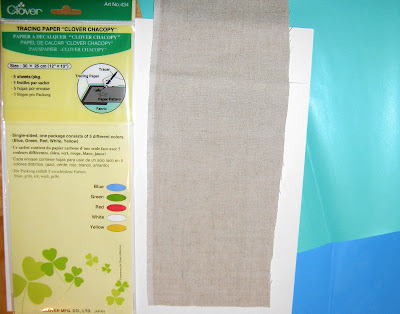 Not surprisingly, there was no visible transfer of the design onto the fabric with either of these colors. There may be minute amounts of chalk on the fabric, but they are no help to me if I can’t see them. I didn’t bother testing the lighter colors.
Not surprisingly, there was no visible transfer of the design onto the fabric with either of these colors. There may be minute amounts of chalk on the fabric, but they are no help to me if I can’t see them. I didn’t bother testing the lighter colors. The result was better than Clover, but uneven. You may be able to see the crescent shape that came through in the photo. Not quite good enough.
The result was better than Clover, but uneven. You may be able to see the crescent shape that came through in the photo. Not quite good enough. With both colors, much more of the design came through onto the fabric, although by this time I was pressing so hard during the tracing that I tore through the paper. These transfers are definitely the best of the group, but they are still incomplete. At this point I was thinking it was a problem fabric and nothing was going to transfer to it.
With both colors, much more of the design came through onto the fabric, although by this time I was pressing so hard during the tracing that I tore through the paper. These transfers are definitely the best of the group, but they are still incomplete. At this point I was thinking it was a problem fabric and nothing was going to transfer to it.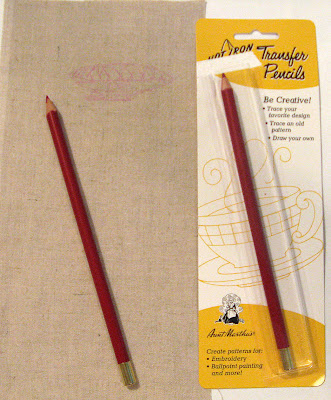 The ironing is an additional step beyond what’s needed with simple tracing, but the results were much better than any of the carbon paper tracings.
The ironing is an additional step beyond what’s needed with simple tracing, but the results were much better than any of the carbon paper tracings. The entire drawing came through perfectly. I love it and I will definitely be using the Sulky pen in the future.
The entire drawing came through perfectly. I love it and I will definitely be using the Sulky pen in the future.
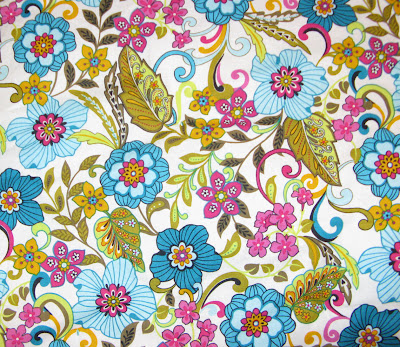
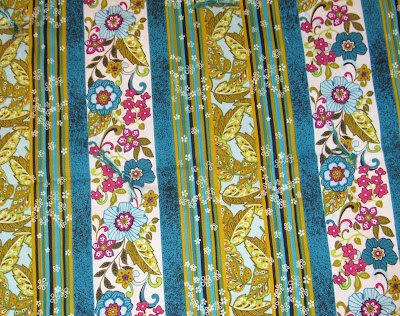 RJR Summer Solstice (2010) fabrics
RJR Summer Solstice (2010) fabrics


 This fabric has had me in a state of paralysis for some time. It looks like blue-green seaweed waving under the silvery water. The pile is silver or gray over a green base. I liked it so much I didn’t want to use it! But sitting in the closet wasn’t doing it any good (although I did store it properly – hung with the selvedge clipped to a hanger) and I convinced myself that such a visually elaborate fabric could work with a simple pattern.
This fabric has had me in a state of paralysis for some time. It looks like blue-green seaweed waving under the silvery water. The pile is silver or gray over a green base. I liked it so much I didn’t want to use it! But sitting in the closet wasn’t doing it any good (although I did store it properly – hung with the selvedge clipped to a hanger) and I convinced myself that such a visually elaborate fabric could work with a simple pattern.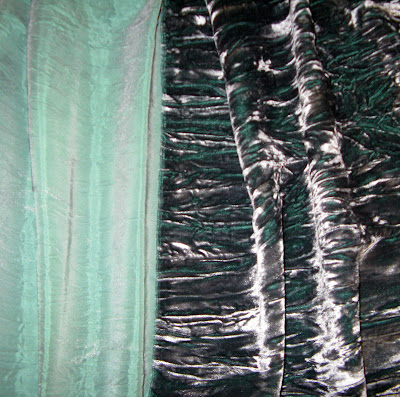
 left: from Piperlime,
left: from Piperlime,  I bound the neck with a bias strip of the velvet. I love how the angle of the crush pattern makes it look like it’s twisted around. I could never have gotten that effect if I did it on purpose!
I bound the neck with a bias strip of the velvet. I love how the angle of the crush pattern makes it look like it’s twisted around. I could never have gotten that effect if I did it on purpose! I finished the seams with tape so that I wouldn’t have to worry about shedding all over myself and the furniture. I had just used up the last of a light mint green on the shoulders and sleeves when my order of vintage rayon binding in “bayleaf” arrived from
I finished the seams with tape so that I wouldn’t have to worry about shedding all over myself and the furniture. I had just used up the last of a light mint green on the shoulders and sleeves when my order of vintage rayon binding in “bayleaf” arrived from  And here is the finished product. The fabric changes color from dark gray with inside light (left) to reflective silver and green in natural light (right).
And here is the finished product. The fabric changes color from dark gray with inside light (left) to reflective silver and green in natural light (right).
 There was even an example of Sant' Angelo’s Chameleon Dress, a slinky knit maxi with long, attached sashes that could be wrapped in many different configurations, much like the modern infinity dress. More about Sant' Angelo and the exhibit
There was even an example of Sant' Angelo’s Chameleon Dress, a slinky knit maxi with long, attached sashes that could be wrapped in many different configurations, much like the modern infinity dress. More about Sant' Angelo and the exhibit 
 recipe
recipe 

 This is one of the fabrics I have. Silver? Green? It’s called “smokey green,” which is close enough.
This is one of the fabrics I have. Silver? Green? It’s called “smokey green,” which is close enough.



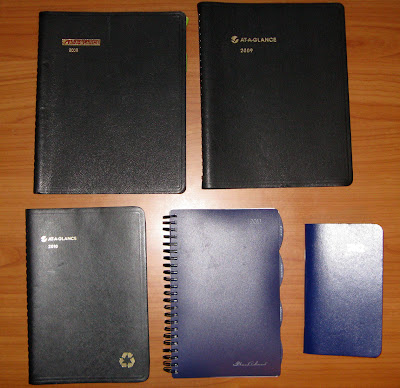

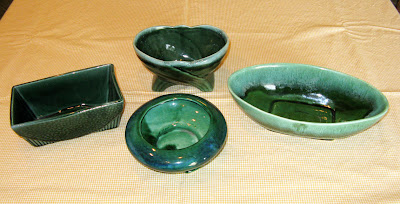
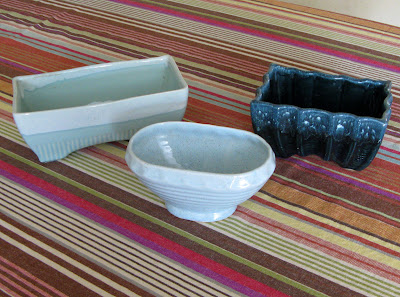


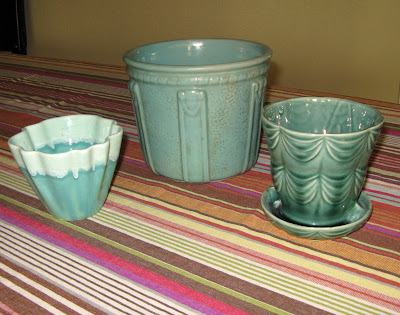
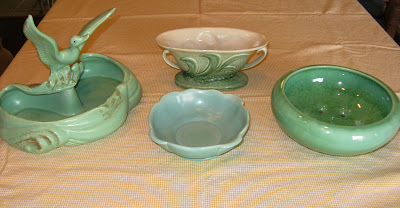


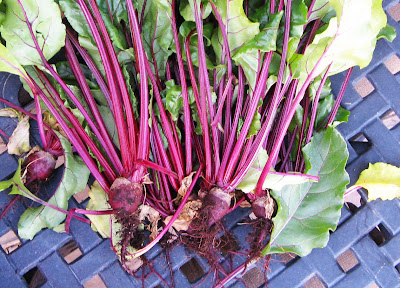

 They were delivered in 3 business days!
They were delivered in 3 business days! All are 45 to 48 inches wide.
All are 45 to 48 inches wide.
 After washing and drying, I was pleased overall with the results, even if I did have brown instead of violet. It was a bit bright though, and sometimes I don’t want to see that much vivid color first thing in the morning!
After washing and drying, I was pleased overall with the results, even if I did have brown instead of violet. It was a bit bright though, and sometimes I don’t want to see that much vivid color first thing in the morning! It is now a light salmon color fading into apricot at the top. I love it, even though it was completely different from what I’d planned.
It is now a light salmon color fading into apricot at the top. I love it, even though it was completely different from what I’d planned. The result was this medium green – it’s brighter than olive, darker than chartreuse, and I don’t know what to call it. But I like it. It’s especially nice that the rayon threads in the embroidery on the tunic picked up the dye so well. Yippee! New shirts!
The result was this medium green – it’s brighter than olive, darker than chartreuse, and I don’t know what to call it. But I like it. It’s especially nice that the rayon threads in the embroidery on the tunic picked up the dye so well. Yippee! New shirts!